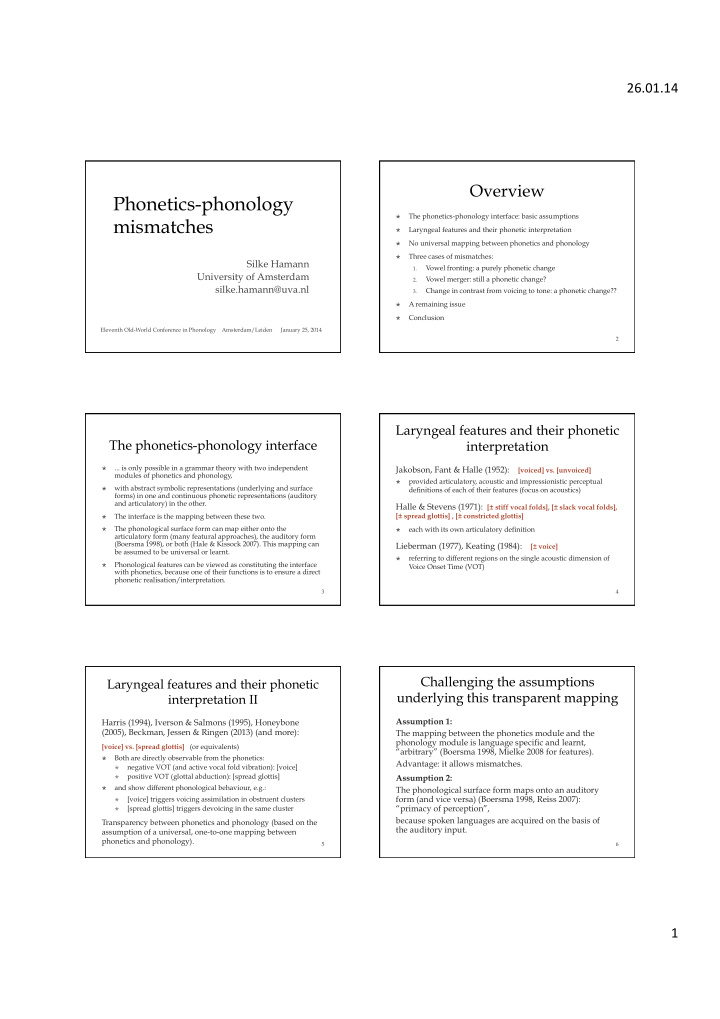



26.01.14 ¡ Overview Phonetics-phonology The phonetics-phonology interface: basic assumptions × mismatches Laryngeal features and their phonetic interpretation × No universal mapping between phonetics and phonology × Three cases of mismatches: × Silke Hamann Vowel fronting: a purely phonetic change 1. University of Amsterdam Vowel merger: still a phonetic change? 2. silke.hamann@uva.nl Change in contrast from voicing to tone: a phonetic change?? 3. A remaining issue × Conclusion × Eleventh Old-World Conference in Phonology Amsterdam/Leiden January 25, 2014 2 Laryngeal features and their phonetic The phonetics-phonology interface interpretation ... is only possible in a grammar theory with two independent Jakobson, Fant & Halle (1952): [voiced] vs. [unvoiced] × modules of phonetics and phonology, provided articulatory, acoustic and impressionistic perceptual × with abstract symbolic representations (underlying and surface × definitions of each of their features (focus on acoustics) forms) in one and continuous phonetic representations (auditory and articulatory) in the other. Halle & Stevens (1971): [± stiff vocal folds], [± slack vocal folds], [± spread glottis] , [± constricted glottis] The interface is the mapping between these two. × The phonological surface form can map either onto the each with its own articulatory definition × × articulatory form (many featural approaches), the auditory form (Boersma 1998), or both (Hale & Kissock 2007). This mapping can Lieberman (1977), Keating (1984): [± voice] be assumed to be universal or learnt. referring to different regions on the single acoustic dimension of × Phonological features can be viewed as constituting the interface × Voice Onset Time (VOT) with phonetics, because one of their functions is to ensure a direct phonetic realisation/interpretation. 3 4 Challenging the assumptions Laryngeal features and their phonetic interpretation II underlying this transparent mapping Harris (1994), Iverson & Salmons (1995), Honeybone Assumption 1: (2005), Beckman, Jessen & Ringen (2013) (and more): The mapping between the phonetics module and the phonology module is language specific and learnt, [voice] vs. [spread glottis] (or equivalents) “arbitrary” (Boersma 1998, Mielke 2008 for features). Both are directly observable from the phonetics: × Advantage: it allows mismatches. negative VOT (and active vocal fold vibration): [voice] × positive VOT (glottal abduction): [spread glottis] Assumption 2: × and show different phonological behaviour, e.g.: The phonological surface form maps onto an auditory × [voice] triggers voicing assimilation in obstruent clusters form (and vice versa) (Boersma 1998, Reiss 2007): × “primacy of perception”, [spread glottis] triggers devoicing in the same cluster × because spoken languages are acquired on the basis of Transparency between phonetics and phonology (based on the the auditory input. assumption of a universal, one-to-one mapping between phonetics and phonology). 5 6 1 ¡
26.01.14 ¡ Transparent mappings for free: Transparent mappings for free Example voicing feature(s) If phonological categories (features or segments) are [voice] - [spread glottis] and VOT: × learnt on the basis of the auditory input, they often simply VOT is insufficient for languages with a four-way mirror input distributions on auditory dimensions. × laryngeal contrast, e.g. Hindi, where VOT values for the E.g., in a language with two high vowels, a front one × plain voiced and the breathy voiced categories largely (with high F2 values) and a back one (with low F2 values), overlap. the learner will create two categories that are distinguished along the auditory dimension of F2, thus VOT is an acoustic measure, not an auditory dimension. × constructs something like [±high F2] or [±front], Lisker & Abramson (1964) acknowledged this problem: “it recall the simulations of feature emergence by {Boersma, × × Chládková, (Benders)} (this conference). seems likely that the voiced aspirates are distinguished from the other voiced category by the presence of low Transparent mappings are by-products of perceptual × amplitude buzz mixed with noise in the interval learning, not a stipulated universal property of the following release of the stop” (p.403) grammar or the acquisition device. 7 8 Transparent mappings for free: Transparent mappings for free: Example voicing feature(s) Example voicing feature(s) Better to use two independent auditory dimensions: Further auditory dimensions involved in voicing contrast: presence vs. absence of periodicity in the signal, × amplitude of the burst, × presence vs. absence of aspiration noise in the signal. × lowering of the pitch in the vowel following a voiced × Languages with a two-way laryngeal contrast usually use one plosive (F0 perturbation), or the other (but see Swedish). shortening of the preceding vowel duration by a voiceless × The fact that the presence of the cue is more salient than its plosive (pre-fortis clipping), absence can explain the prevalence of phonologically active privative features: ... ({Abramson, Lisker}) [voice] is a direct consequence of the saliency of × There is no one-to-one mapping. periodicity (versus its absence), Listeners and learners use whatever is there in the auditory [spread glottis] of the presence of aspiration noise (versus × its absence). form! 9 10 Learning a voicing feature on the basis of the auditory input Phonetics-phonology mismatches Study by Narayan, Gorman & Swingley (2008, BUCLD) using large × Where a language has phonological processes that are corpora: not in line with the phonetics of the segments Acquisition of the voicing distinction (in plosives) by AE × involved. infants, Motherese shows larger overlap in VOT than normal (adult- × × These can only be detected by looking at the directed) speech, but enhancement of the pitch cue (F0 perturbation). phonological behaviour (not at the phonetics). Conclusion that there are “multiple cues to relevant features”. × × How can such mismatches be learned? Infants start off with pitch as most reliable cue to voicing contrast. × Children learn features not only from the perception, AE Motherese could be considered a case of mismatch between phonetics and phonology in a universal-mapping approach. but also from phonological alternations. Problematic since they didn’t distinguish the perceptual cues of aspiration noise and periodicity (to be fair, they called their study “the acoustics of [voice]...”). 11 12 2 ¡
Recommend
More recommend